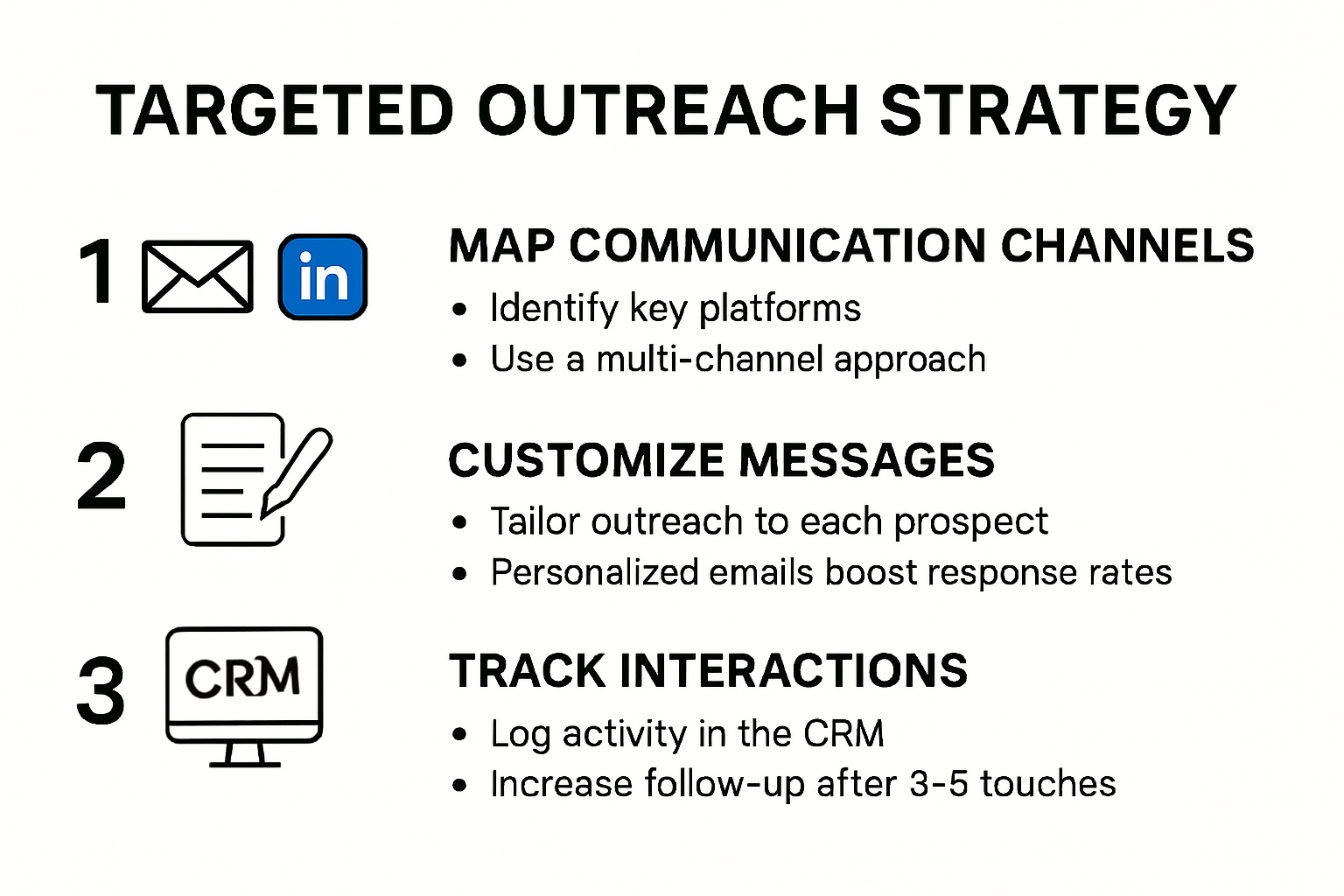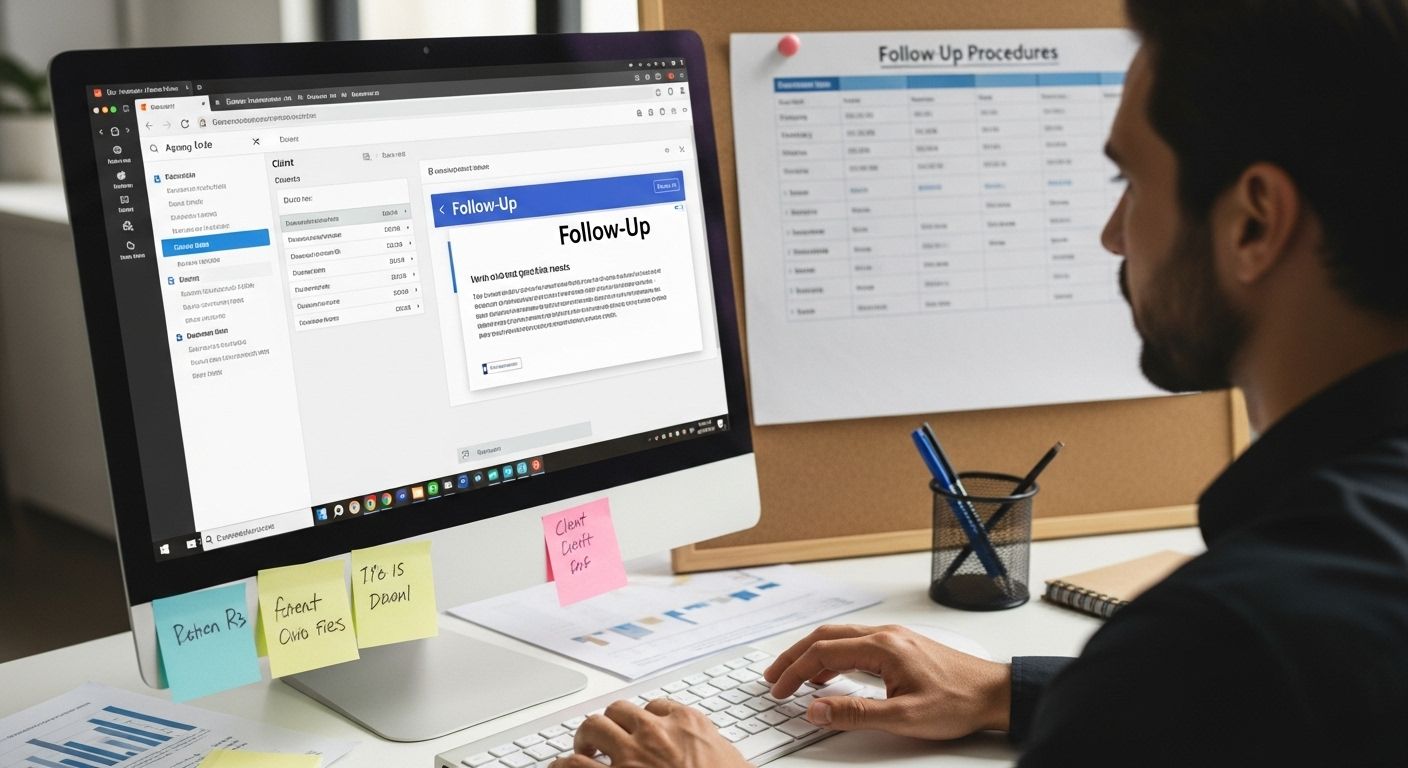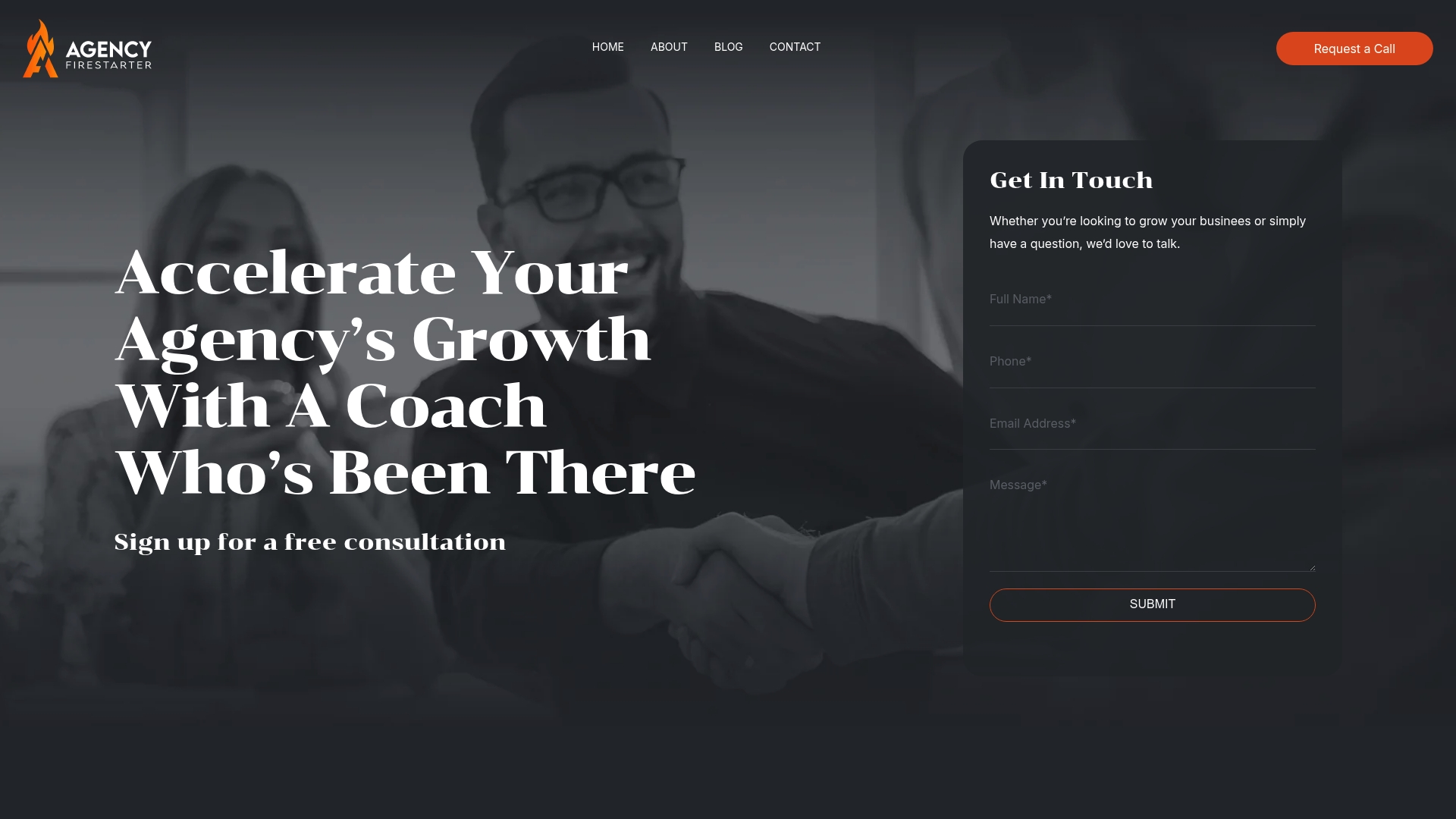
Master Prospecting for New Clients in 2025
Landing the right clients can make or break your agency’s future. Agencies with a clearly defined ideal client profile attract up to 70 percent more high-value accounts compared to those without one. Most agencies scramble for leads, hoping for a lucky catch. The real secret is turning prospecting into a precision-guided process that draws in your dream clients again and again.
Table of Contents
- Step 1: Define Your Ideal Client Profile
- Step 2: Research Target Markets And Niches
- Step 3: Develop A Compelling Value Proposition
- Step 4: Create A Targeted Outreach Strategy
- Step 5: Implement Follow-Up Procedures
- Step 6: Assess And Optimize Your Prospecting Efforts
Use this table to review main prospecting steps, their goals, and recommended tools. This quick overview helps you organize your process and select the right resources at each stage.
| Step | Primary Goal | Key Tools/Resources |
|---|---|---|
| Define Ideal Client Profile | Identify ideal-fit clients for focused prospecting | Client analysis worksheets, scoring criteria |
| Research Markets & Niches | Uncover promising markets and client segments | LinkedIn Sales Navigator, industry reports |
| Develop Value Proposition | Articulate unique solutions for client problems | Feedback surveys, competitor analysis |
| Targeted Outreach Strategy | Engage prospects through personalized connections | CRM software, LinkedIn, email tools |
| Implement Follow-up Procedures | Build relationships with meaningful value communications | CRM reminders, content templates |
| Assess & Optimize Prospecting | Continuously improve outreach and targeting methods | KPI trackers, analytics dashboards |
Quick Summary
| Key Point | Explanation |
|---|---|
| 1. Define Your Ideal Client Profile | Clearly outline characteristics of your perfect client to enhance targeting and attraction during prospecting. |
| 2. Conduct Thorough Market Research | Utilize digital tools to understand potential markets, identifying unique challenges and growth patterns in niche segments. |
| 3. Develop a Compelling Value Proposition | Articulate the unique benefits your agency offers, demonstrating how you solve client challenges effectively and differently. |
| 4. Implement Targeted Outreach Strategies | Use aligned communication channels and personalize messages to engage potential clients based on their preferences. |
| 5. Establish Systematic Follow-Up Procedures | Design a structured follow-up process that adds value and keeps communication open with potential clients, respecting their preferences. |
Step 1: Define Your Ideal Client Profile
Successful prospecting for new clients begins with crystal clear understanding of who you want to work with. Defining your ideal client profile is not just a theoretical exercise but a strategic roadmap that transforms your approach to acquiring new business. The more precisely you can describe your perfect client, the more effectively you can target and attract them.
Start by analyzing your current most successful client relationships. What characteristics do they share? Consider factors beyond basic demographics like industry, company size, and revenue. Dig deeper into their business challenges, growth aspirations, organizational culture, and decision making processes. Your ideal client profile should capture both quantitative and qualitative attributes that signal an exceptional match for your services.
Create a comprehensive profile document that includes key dimensions like revenue range, growth stage, technological maturity, leadership philosophy, and specific pain points your agency uniquely solves. This profile becomes your strategic filter for prospecting efforts. When you encounter potential clients, you can quickly assess their alignment with your ideal client criteria. Learn more about strategic client matching to refine your approach.
Here is a checklist summarizing the key elements to include when defining your ideal client profile. Refer to this table to ensure your profile covers all critical dimensions for effective prospecting.
| Dimension | Description | Example Criteria |
|---|---|---|
| Revenue Range | Financial scope of target clients | $2M-$10M annual revenue |
| Growth Stage | Stage of company development | Scaling startups or established growing businesses |
| Technological Maturity | Level of tech adoption and readiness | Advanced SaaS infrastructure |
| Leadership Philosophy | Values and beliefs of decision makers | Innovation-driven, open to collaboration |
| Pain Points | Main business challenges your agency solves | Outdated digital strategy, low conversion rates |
| Cultural Compatibility | Alignment with your agency’s way of working | Values transparency, fast decision cycles |
| Strategic Alignment | How well they fit with your agency’s strengths | Needs brand transformation your team delivers |
Consider developing a scoring system that helps you objectively evaluate potential clients. This might include weighted criteria such as:
- Strategic alignment with your agency’s strengths
- Potential for long term partnership
- Financial health and growth trajectory
- Cultural compatibility
- Openness to innovative solutions
Remember that your ideal client profile is not static. Regularly review and update it based on your evolving business capabilities, market trends, and emerging opportunities. By maintaining a dynamic, well defined client profile, you transform prospecting from a hit or miss activity into a precision targeting strategy that attracts high value clients who are genuinely excited to work with your agency.
Step 2: Research Target Markets and Niches
Researching target markets and niches transforms prospecting for new clients from a random approach to a strategic, precision-driven process. This step bridges your ideal client profile with actual market opportunities, enabling you to identify where your most promising potential clients are concentrated.
Begin by leveraging powerful digital research tools that provide comprehensive market insights. Platforms like LinkedIn Sales Navigator, industry association databases, and specialized market research reports can reveal intricate details about specific business sectors. Look beyond surface level demographics and dive into understanding the unique challenges, technological ecosystems, and growth patterns within each potential market segment.
Conducting thorough market segmentation requires a multifaceted approach. According to research from the Small Business Administration, effective market research involves analyzing several critical dimensions:
- Economic indicators within specific industries
- Technological adoption rates
- Competitive landscape complexity
- Potential market saturation
- Emerging business trends
Pay special attention to sectors experiencing significant transformation or technological disruption. These environments often create opportunities for agencies offering innovative solutions. Industries like healthcare technology, sustainable energy, remote work infrastructure, and artificial intelligence implementation represent fertile ground for agencies with specialized expertise.
Document your market research findings systematically. Create a comprehensive market landscape map that categorizes potential niches, their characteristics, growth potential, and alignment with your agency’s strengths. This living document will become an invaluable strategic asset, guiding your prospecting efforts and helping you prioritize the most promising market segments. Regularly update this research to stay ahead of evolving business landscapes and emerging client needs.
Step 3: Develop a Compelling Value Proposition
A compelling value proposition transforms prospecting from cold outreach to strategic engagement. This critical step defines exactly why potential clients should choose your agency over every other option available. Your value proposition is not merely a marketing statement but a powerful articulation of the unique transformational experience you deliver.
Craft your value proposition by deeply understanding the specific business challenges your ideal clients face. Go beyond generic statements and develop a narrative that demonstrates precise understanding of their pain points. According to Harvard Business School Online, the most effective value propositions communicate the tangible outcomes clients can expect, not just the services you provide.
Construct your value proposition using a strategic framework that answers three fundamental questions: What specific problem do you solve? How do you solve it differently from competitors? What measurable results can clients anticipate? Quantify your impact wherever possible, using concrete metrics like percentage improvements, cost reductions, or revenue growth potential. This approach transforms your proposition from abstract claims to a data driven promise of value.
Consider creating multiple value proposition variations tailored to different market segments or client personas. Each version should speak directly to the unique needs and aspirations of that specific audience. Your variations might emphasize different strengths such as:
- Technological innovation
- Cost efficiency
- Speed of implementation
- Customization capabilities
- Proven track record of success
Finally, validate your value proposition through direct feedback from existing clients and prospects. Test different language, refine your messaging, and continuously evolve your narrative to remain relevant and compelling. A truly exceptional value proposition becomes your most powerful prospecting tool, attracting ideal clients who recognize the distinctive value you bring to their business challenges.
Step 4: Create a Targeted Outreach Strategy
A targeted outreach strategy transforms random networking into a precision instrument for attracting ideal clients. This step converts your research and value proposition into actionable connection tactics that systematically expand your agency’s client base. Your outreach strategy must be intentional, personal, and strategically designed to cut through the noise of digital communication.
Begin by mapping multiple communication channels that align with your target market’s preferences. Professional platforms like LinkedIn, industry specific forums, targeted email campaigns, and strategic networking events become your primary connection points. Explore our advanced business development techniques to refine your approach. Customize your communication approach for each channel, understanding that executives in technology firms might prefer direct LinkedIn messages, while creative industry professionals might respond better to personalized email introductions.
According to research from Duke University, successful outreach requires a systematic approach. Develop a structured tracking system that monitors your interactions, response rates, and potential opportunities. Use customer relationship management (CRM) tools to document every touchpoint, ensuring no potential connection falls through the cracks.
Craft your outreach communications with surgical precision. Each message should demonstrate deep understanding of the recipient’s specific business challenges, reference recent company achievements, and articulate how your agency can provide transformative solutions. Your communications must transcend generic templates and showcase genuine interest and expertise.
Consider developing an outreach strategy that includes multiple contact points:
- Initial personalized connection request
- Value driven follow up message
- Relevant content sharing
- Strategic invitation to discuss business challenges
- Periodic meaningful check ins
Remember that effective outreach is about building genuine relationships, not just securing immediate sales. Patience, consistency, and authentic engagement are your most powerful tools in transforming cold contacts into potential long term client partnerships.

Step 5: Implement Follow-Up Procedures
Follow-up procedures are the critical heartbeat of successful client prospecting, transforming initial connections into meaningful business relationships. Effective follow-up is not about persistent pestering but strategic, value driven engagement. Your approach must demonstrate genuine interest, professional persistence, and a commitment to solving potential clients’ business challenges.
Design a systematic follow-up workflow that balances frequency with meaningful content. Utilize customer relationship management (CRM) tools to schedule and track interactions, ensuring no potential opportunity slips through the cracks. Learn more about advanced client engagement strategies to refine your approach. Each follow-up communication should provide additional value, whether through industry insights, relevant case studies, or personalized recommendations that address the specific needs you previously identified.
Create a multi-touch follow-up sequence that respects professional boundaries while maintaining consistent engagement. Your communication strategy should include a carefully orchestrated series of touchpoints across different channels. Email remains a primary communication method, but do not hesitate to leverage phone calls, personalized LinkedIn messages, and even strategic direct mail when appropriate.

Implement a tiered follow-up approach that adapts to each prospect’s responsiveness and level of interest. Some potential clients might require frequent, gentle nudges, while others prefer minimal, high impact interactions. Develop a nuanced communication strategy that reads and respects individual communication preferences.
Consider establishing a follow-up framework that includes:
- Initial follow-up within 48 hours of first contact
- Strategic value add communication every 7-10 days
- Personalized content sharing based on prospect’s industry
- Periodic check-ins that demonstrate continued interest
- Graceful exit strategy for unresponsive prospects
Track and analyze your follow-up performance meticulously. Monitor metrics like response rates, conversion times, and engagement levels to continuously refine your approach. Remember that successful follow-up is an art of balance persistence with genuine value, transforming initial contacts into long term business partnerships.
Step 6: Assess and Optimize Your Prospecting Efforts
Assessing and optimizing your prospecting efforts transforms raw data into strategic insights that continuously improve your client acquisition process. This critical step turns your prospecting approach from a static strategy into a dynamic, adaptive system that evolves with market conditions and your agency’s growing capabilities. Continuous improvement is not just a goal but a fundamental operational philosophy.
Explore our comprehensive business development strategies to gain deeper insights into performance optimization. Begin by establishing a robust tracking mechanism that captures comprehensive data across every stage of your prospecting funnel. Implement key performance indicators that go beyond simple metrics like conversion rates, diving into nuanced measurements such as client quality, long-term engagement potential, and alignment with your ideal client profile.
According to research from the University of Florida, effective prospecting requires systematic evaluation of your approach. Conduct quarterly deep dive assessments that analyze your prospecting channels, communication strategies, and conversion rates. Identify patterns of success and areas requiring refinement. Pay special attention to the qualitative aspects of your interactions, not just quantitative metrics. Understanding why certain prospects engage while others disengage provides invaluable strategic intelligence.
Develop a comprehensive optimization framework that includes:
- Detailed performance tracking across all prospecting channels
- Regular strategy recalibration based on data insights
- Continuous skills training for your prospecting team
- Adaptive communication approach tailored to market shifts
- Systematic feedback collection from successful and unsuccessful interactions
Remember that optimization is an ongoing process. Your prospecting strategy should be a living document, constantly refined through disciplined analysis, market intelligence, and a commitment to continuous improvement. Embrace data as your strategic ally, allowing empirical insights to guide your agency’s client acquisition evolution.
Ready to Transform Your Prospecting Results in 2025?
Unlocking new client growth is challenging, especially when you face unclear ideal profiles, scattered outreach, and missed follow-up opportunities. The article “Master Prospecting for New Clients in 2025” reveals just how critical a targeted system is for agency owners looking to grow. If vague strategies or inconsistent results are holding your agency back, you need trusted guidance to move forward with confidence.

Break through every barrier to prospecting success with hands-on support from Agency Firestarter. We offer strategic coaching and personalized mentorship to help you refine your approach at every stage, from defining your client profile to optimizing outreach and nurturing real business relationships. Our programs go beyond theory. We deliver actionable steps you can implement immediately and support you as you refine your systems for rapid growth. See how agencies like yours are finding success with our business growth coaching and practical sales strategies. Visit Agency Firestarter now to claim your free consultation and discover what focused prospecting can do for your agency this year. Act now. The right clients are waiting.
Frequently Asked Questions
What is the ideal client profile and why is it important for prospecting?
The ideal client profile defines the characteristics of the clients who are the best fit for your agency. It is crucial for prospecting as it helps tailor your approach to attract and engage with clients who align with your strengths and values.
How can I effectively research target markets and niches for client prospecting?
You can research target markets by utilizing digital tools such as LinkedIn Sales Navigator, industry reports, and market analysis. Focus on identifying business challenges, technological adoption, and growth trends within specific sectors to pinpoint your most promising prospects.
What makes a compelling value proposition for attracting new clients?
A compelling value proposition clearly articulates the unique benefits and measurable outcomes your agency provides. It should address specific client pain points and differentiate your agency from competitors, focusing on tangible results that resonate with your target audience.
Why is follow-up critical in client prospecting, and how should it be structured?
Follow-up is essential because it helps nurture initial connections into lasting business relationships. A structured follow-up strategy should include timely communications that provide value, such as industry insights or personalized recommendations, while respecting the prospect’s communication preferences.
Recommended
- Agency Business Development: Proven Strategies for Growth – Business Coach For Digital Marketing Companies, SEO, Social Media Agencies
- Top Digital Marketing Trends 2025 for Growing Agencies – Business Coach For Digital Marketing Companies, SEO, Social Media Agencies
- Client Onboarding Processes: Step-by-Step Success Guide – Business Coach For Digital Marketing Companies, SEO, Social Media Agencies
- Developing a Sales Process for Agencies and Service Firms – Business Coach For Digital Marketing Companies, SEO, Social Media Agencies
